Gear Oil
-
- Shear Stability: The Key to Proper EAL Gear Oil Selection Marine News, Jun 2015 #26
Selection of gear oil for marine thrusters or a stern tube lubricant for use with propeller shaft bearings is often based on analyzing price/performance characteristics of the lubricant and its availability. Now with the implementation of the 2013 Vessel General Permit, this analysis must be expanded to include environmentally acceptable lubricants (EALs) that meet the new EPA standards. To meet environmental requirements, EALs are blended from base oils other than mineral oil. They still meet the same lubricant objective – providing long-term equipment protection. That said, it is also worthwhile to focus on how the new EALs meet one particular criterion for analysis; namely, their ability to resist shearing under load.
Applications Requiring EALs
The 2013 Vessel General Permit requires that lubricants used in applications with an oil-to-sea interface meet specific requirements for biodegradability, toxicity and bioaccumulation. The permit allows for a phased transition to EALs based on product availability, dry-dock schedules, and approval of the lubricant from the original equipment manufacturer (OEM) of the application. OEMs are now in the process of testing and approving EALs for use in their equipment. All of the major stern tube system manufacturers have approved at least one EAL. Many of the thruster manufacturers have also approved EALs for new installations as well as equipment retrofitted with compatible seals.
In general, a complete performance analysis of an EAL gear oil or stern tube lubricant should include an assessment of thermal, oxidative, and hydrolytic stability to estimate the projected life of the oil under operating conditions. These results can be compared to the initial purchase price of the lubricant for a total cost of ownership value. Other measures include its ability to protect the equipment from wear, scuffing, pitting, and corrosion. A high performance lubricant will extend equipment service life and reduce unplanned downtime, therefore contributing to your bottom line profits.
Evaluation of lubricant viscosity is imperative to protect all the components in a system. The kinematic viscosity of oil is affected by a number of factors. One inherent physical property of a lubricant is its tendency to thicken in cooler temperatures and thin at higher temperatures. This change in viscosity as a function of temperature is called Viscosity Index, or VI. As a general rule, the higher the VI, the less the oil is affected by temperature change.
When formulating a lubricant, viscosity improvers (which are often polymer based) can be used to increase the VI. Viscosity modifiers are used in some EALs to push the viscosity of low viscosity biodegradable oil to a higher viscosity value. Using viscosity modifiers with a low viscosity base oil to manufacture a lubricant can be more cost effective than to use a high viscosity base stock. However, a lubricant containing viscosity improvers may not be as effective in high shear, high pressure, and extreme temperatures. In these conditions, the oil can exhibit a temporary loss of viscosity. When shearing continues or if the forces are high enough, the polymers can break down, eventually causing a permanent loss of viscosity.
Shear Stability Factors
One measure of a lubricant’s protective value is its ability to withstand shearing under pressure. Shear stability describes a lubricant’s ability to resist a decrease in viscosity due to exposure to mechanical loads. Maintaining the appropriate and OEM recommended viscosity is critically important to both protect the equipment and to extend the time between oil change intervals.
Lubricant thinning under stress is the result of the breakdown of viscosity modifiers. Under stress, viscosity modifiers can either align at the molecular level causing a temporary loss of viscosity – or they can break apart causing a permanent loss in viscosity. Either scenario reduces their effectiveness in service. Increasing viscosity through the use of high viscosity base stocks, without the use or only moderate use of viscosity modifiers, tend to have better shear stability.
Lubricant Effects on Stern Tube Bearings/Shaft & Thrusters
Stern tube systems and thrusters stress the lubricant due to high loads, speed of rotation, and heat. In a stern tube system, the weight of the propeller shaft and high thrust forces, combined with the speed of rotation and surface area create significant shear stress on the lubricant. As the lubricant protects the components and improves efficiency by reducing friction and generation, it also relies upon two main properties: viscosity and additives.
Determining proper viscosity is necessary to ensure a proper elastohydrodynamic (EHD) lubrication film. This film is a wedge of oil that builds up between two moving surfaces and provides separation. It is this separation that helps protect the surfaces from wear, pitting, and scuffing. EHD film thickness is a function of speed, pressure, surface condition, temperature, and viscosity.
A reduction in viscosity, either temporarily or permanently will reduce the lubricant’s ability to create a fluid film to separate the shaft from the bearing. Thrusters operate under extreme loads as they transfer power generated by the vessels engines, through the bevel gears of the z-drive and on to the propeller. When the correct viscosity is not maintained, an increase in micro-pitting and gear wear may occur. The lubricant selected to protect shafts, bearings, and gears must be able to withstand high shearing forces.
In practice, a good sampling program can be used to monitor the condition of the oil. Tracking the viscosity over time will detect loss of viscosity due to shearing. That’s why monitoring trending data is part of a successful oil analysis program. The condition of oil should always be checked against a representative baseline. A baseline can be established by directly sampling the sump soon after filling with fresh oil and after a short duration of operation. The frequency of sampling is typically established by the OEM or depending on the application and operating conditions. An adequate interval is typically based on the number of service hours or at set intervals to check for viscosity stability. If one of the tested parameters ever falls out of the OEM recommended range for the equipment, it should be replaced and a new baseline should be established.
While an oil analysis program will help accurately measure how the current oil is performing, there are numerous tests that a manufacturer can perform in the lab to characterize the oil performance to help the OEM or end user make an informed purchasing decision prior to filling the system/gearbox.
A preferred method is the standard test method CEC L-45-A-99, also known as the KRL Tapered Roller Bearing test. Used by OEMs and lubricant manufacturers, this test simulates lubricant performance under shear stress in actual gear and bearing applications. It is considered the most severe of the available shear stability tests and offers the best correlation to actual field performance. The CEC L-45-A-99 test simulates a high shear condition to accelerate the breakdown of oil viscosity. To accomplish this, tapered roller bearings are used because the large surface area of the roller exposes the oil to a high percentage of shear. The test bearings are run at 1,450 rpms for 20 or 100 hours under a load equal to 5,000 N, at 60° C. The results are calculated by measuring the percentage of viscosity change between the oil viscosity pretest and the oil viscosity post test. A small value indicates a high shear stability, while a high value indicates poor shear stability.
Results of Testing Shear Stability
Internal testing of various EALs using the test method CEC L-45-A-99 has produced a wide range of results among the sample lubricants. Synthetic ester based products that did not use viscosity modifiers produced the best results. Even after a short test duration of 100 hours, two of the samples with viscosity modifiers showed a minimum of 50% loss in viscosity. However the two oils that were formulated without viscosity improvers maintained a consistent viscosity.
Even a small drop in viscosity can drop the ISO viscosity grade down into the next VI category permanently. Running too light of an oil viscosity can reduce the lubricant’s ability to provide a sufficient oil film. If this occurs, lubricant protection is compromised, leading to higher probability of premature wear, scuffing, and pitting.
Conclusion
EALs are formulated to protect the environment. But there is no need to select an EAL that compromises the protection of thrusters or shaft bearings. Careful selection of EALs is necessary to prevent failures of bearings and gears. Protecting against shearing stresses is achieved by selecting EALs with a high VI. But lubricants that employ viscosity modifiers to raise VI can compromise shear stability. Selecting an EAL using a base oil with an inherently high VI – assisted by a logical sampling program – will ensure the high level of shear protection that meets today’s environmental and equipment requirements.
(As published in the June 2015 edition of Marine News - http://magazines.marinelink.com/Magazines/MaritimeNews)
-
- Clipper III: A Case Study In Monitoring Systems Maritime Reporter, Sep 1994 #74B
sensors (one on each of 16 exhaust ports on each main engine, one each monitoring fresh water intake, engine and generator oil, and reduction gear oil); and 14 pressure sensors (for each engine, generator oil, cooling water jackets, raw water, reduction gear oil, bearing, and reverse/steering)
-
- VGP-Compliant Lubricants from Panolin Marine News, Nov 2013 #55
esters and specially developed additives to achieve 100% VGP and sVGP compliance without sacrificing performance. The range includes hydraulic fluids, gear oil and production line control fluids, as well as lubricants for stern tubes, gear boxes, cables and sliding parts. By decreasing the frequency of oil
-
- Cummins-Powered Excursion Boat 'Missouri River Queen' Delivered By Marine Builders Maritime Reporter, Jul 16, 1985 #8
engine controls are Marine Builders, Inc. design, and feature full pilothouse instrumentation including low oil pressure, high water temperature and gear oil pressure alarms.
-
- Deck Machinery: Five Stress Areas Maritime Reporter, Nov 2017 #20
. 2. Moving parts in gear boxes used in deck pumps, winches and cranes are at the heart of any deck operation. The type and quality of the gear oil used to lubricate the moving parts will determine how long between gear box overhauls, how often the oil must be replaced, and even how much energy
-
- Klüberbio Lubricants Meet EPA Standards Maritime Reporter, Jan 2014 #54
Klüberbio EG 2 gear oil for thrusters and Klüberbio RM 2 stern tube oil now carry the European Ecolabel, signifying compliance with the U.S. Environmental Protection Agency’s (EPA’s) 2013 Vessel General Permit (VGP). The EU Ecolabel is a label of environmental excellence that is awarded to products and
-
- Ship-to-Turbine Oil Change System Maritime Reporter, May 2014 #57
wind farm off the Norfolk coast where it reportedly was demonstrated the STT system helped to complete the entire evacuation, flushing and refill of the gear oil system in less than four hours total pumping time per turbine. The company believes that the Ship-to-Turbine method has the potential to revolutionize
-
- Caicos Petroleum Services Establishes Transfer Facility Maritime Reporter, Jul 15, 1980 #41
by Lloyd's of London, and includes a personnel boat for crew changes, utility boat, 10-foot by 20-foot sea cushion fenders, hoses, communications gear, oil dispersant, and related transfer tackle. Mooring masters are provided by International Pilots of Atlantic Highlands, N.J. For further information
-
- Gulf Fleet M a r i n e Adds 9 5 t h Vessel To Expanding O f f s h o r e Service Fleet Maritime Reporter, Mar 15, 1980 #12
carries 186,500 gallons of fuel oil, 1,700 gallons of lube oil, a dirty oil tank of 1,700 gallons, 1,000 gallons of hydraulic oil, 1,000 gallons of gear oil, and 23,850 gallons of potable water. Steering is provided by a Sperry Universal autopilot, with a Sperry SR130 gyrocompass, located in a forward
-
- Penske Literature Details New Onboard Diagnostic System Maritime Reporter, Nov 1986 #56
pressures from the raw water pump, the fuel pump and the turbocharger compressor discharge, incorporates a pyrometer to measure exhaust gas and gear oil temperatures, and even checks the water and oil.. . without even opening the "hood". Penske GM Power's engineering team has brought the computer
-
- Packing Solutions Help Bear Set Sail Maritime Reporter, May 2002 #57
reduction gearbox. The stern outdrive shaft's stuffing box could not maintain a good seal for any length of time, and would allow the leaking gear oil to sling off the rotating shaft onto adjacent clutches. Different types of compression packing had been tried, including graphite-impregnated,
-
- Bollinger Christens 8,000-hp Towboat, Bootsie B Maritime Reporter, Jul 2001 #14
140,500 gallons of fuel, 6,150 gallons of oil, 33,300 gallons of fresh water, 104,000 gallons of ballast water and 540 gallons each of hydraulic and gear oil. Deck equipment includes six Patterson 65 winches: Schoellhorn-Albrecht 10 hp-two speed capstans; 14, 48-in. Nabrico kevels: 10 Blackburn roller chock
-
 )
March 2024 - Marine Technology Reporter page: 42
)
March 2024 - Marine Technology Reporter page: 42NEW TECH OCEANOLOGY INTERNATIONAL 2024 Image courtesy Greg Trauthwein Image courtesy BIRNS MacArtney launches the new ultra-compact ø12.7 mm SubConn Nano connector. Innovative connectivity built on 45 years of ? eld-proven and market-trusted design. Image courtesy MacArtney Birns celebrated its 70th
-
 )
March 2024 - Marine Technology Reporter page: 39
)
March 2024 - Marine Technology Reporter page: 39Photo courtesy Global Ocean Design Figure 7 A 35Ah AGM lead-acid battery is tested using the West Mountain Radio CBA to show the effect of simply ? lling the battery voids with mineral oil as a compensating ? uid. The CBA is programmed to cut-off at a voltage of 10.50v. The top line (red) shows the
-
 )
March 2024 - Marine Technology Reporter page: 36
)
March 2024 - Marine Technology Reporter page: 36LANDER LAB #10 Of special interest for marine applications, LiPo batteries are Shipping any kind of lithium battery can be a challenge, and offered in a “pouch” design, with a soft, ? at body. The pouch IATA regs vary with the batteries inside or outside an instru- is vacuum-sealed, with all voids ?
-
 )
March 2024 - Marine Technology Reporter page: 35
)
March 2024 - Marine Technology Reporter page: 35Figure 1 A self-righting vehicle design with buoyancy high and weight low, WHOI’s SeaBED AUV captures the attention of a pair of curious Antarctic penguins as it is deployed from the British research vessel James Clark Ross. Vehicle designers allowed for temperature reduction of battery capacity. Recharge
-
 )
March 2024 - Marine Technology Reporter page: 33
)
March 2024 - Marine Technology Reporter page: 33regulated industry in the world.” How- ever, commercial success depends on many factors, not least a predictable OPEX. Over the past four years, SMD has worked with Oil States Industries to calculate cost per tonne ? gures for prospective customers. Patania II uses jet water pumps to Oil States’
-
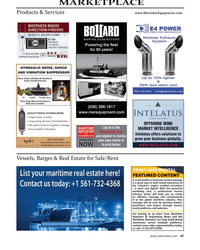 )
April 2024 - Maritime Reporter and Engineering News page: 47
)
April 2024 - Maritime Reporter and Engineering News page: 47MARKETPLACE Products & Services www.MaritimeEquipment.com Powering the fleet for 60 years! HYDRAULIC NOISE, SHOCK AND VIBRATION SUPPRESSOR Noise, Shock, VibraO on & PulsaO on in Quiet, Smooth Flow Out Oil Bladder Nitrogen (blue) Manufactured by MER
-
 )
April 2024 - Maritime Reporter and Engineering News page: 41
)
April 2024 - Maritime Reporter and Engineering News page: 41Nautel provides innovative, industry-leading solutions speci? cally designed for use in harsh maritime environments: • GMDSS/NAVTEX/NAVDAT coastal surveillance and transmission systems • Offshore NDB non-directional radio beacon systems for oil platform, support vessel & wind farm applications
-
 )
April 2024 - Maritime Reporter and Engineering News page: 38
)
April 2024 - Maritime Reporter and Engineering News page: 38Tech Files Latest Products, Systems and Ship Designs Zero-Emission Mooring Service of a Tanker Consulmar achieved a milestone by executing what it calls ing boat Castalia, which operates on full electric propulsion. the world's ? rst zero-emissions mooring service for a tanker. Equipped with two 150 kW
-
 )
April 2024 - Maritime Reporter and Engineering News page: 35
)
April 2024 - Maritime Reporter and Engineering News page: 35SIMULATION e have a close relationship with tech- Realism is prized beyond immersive, photo-realistic visu- nology, evidenced by, for example, als, and providers are introducing increasingly accurate func- the phones we are estimated to un- tionality. FORCE Technology’s upcoming DEN-Mark2 math- lock around
-
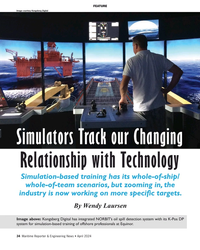 )
April 2024 - Maritime Reporter and Engineering News page: 34
)
April 2024 - Maritime Reporter and Engineering News page: 34FEATURE Image courtesy Kongsberg Digital Simulators Track our Changing Relationship with Technology Simulation-based training has its whole-of-ship/ whole-of-team scenarios, but zooming in, the industry is now working on more speci? c targets. By Wendy Laursen Image above: Kongsberg Digital has integrated
-
 )
April 2024 - Maritime Reporter and Engineering News page: 32
)
April 2024 - Maritime Reporter and Engineering News page: 32FEATURE A closeup of a blade installation process taken via drone. A blade handling system is apparent (in yellow). Images courtesy of Mammoet requirement for the development of these cranes, particularly ling area. This would result in a major time and fuel saving. in ? oating offshore wind,” says
-
 )
April 2024 - Maritime Reporter and Engineering News page: 25
)
April 2024 - Maritime Reporter and Engineering News page: 25RADM PHILIP SOBECK, MILITARY SEALIFT COMMAND Photo by Brian Suriani USN Military Sealift Command From a global supply chain perspective, What makes MSC so vital to the we’ve learned a lot about dealing with Navy’s ? eet and our military disruptions. COVID delivered a big forces around the world? wake-up
-
 )
April 2024 - Maritime Reporter and Engineering News page: 21
)
April 2024 - Maritime Reporter and Engineering News page: 21ROB LANGFORD, VP, GLOBAL OFFSHORE WIND ob Langford has worked in the offshore industry ABS. “We are growing and evolving our services across all for more than three decades, ‘cutting his teeth’ offshore infrastructure along with our continued support to the in a UK design ? rm working in the North Sea
-
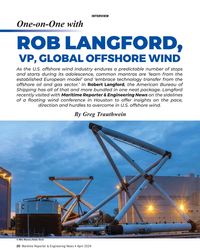 )
April 2024 - Maritime Reporter and Engineering News page: 20
)
April 2024 - Maritime Reporter and Engineering News page: 20INTERVIEW One-on-One with ROB LANGFORD, VP, GLOBAL OFFSHORE WIND As the U.S. offshore wind industry endures a predictable number of stops and starts during its adolescence, common mantras are ‘learn from the established European model’ and ‘embrace technology transfer from the offshore oil and gas
-
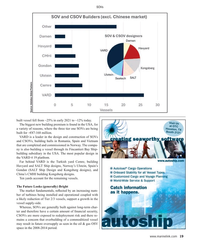 )
April 2024 - Maritime Reporter and Engineering News page: 19
)
April 2024 - Maritime Reporter and Engineering News page: 19SOVs Source: Intelatus Global Partners built vessel fell from ~25% in early 2021 to ~12% today. Visit Us The biggest new building premium is found in the USA, for at OTC Houston, TX a variety of reasons, where the three tier one SOVs are being Booth 2121 built for ~€87-168 million. VARD is a leader in
-
 )
April 2024 - Maritime Reporter and Engineering News page: 18
)
April 2024 - Maritime Reporter and Engineering News page: 18MARKETS & gas activity returns, we anticipate that supply of the vessels The Question of Emissions to offshore wind projects will reduce, driving demand for ad- Given that SOVs and CSOVs operate in a segment target- ditional CSOVs. ing reduced emissions, and many operate in the North Eu- Outside of China
-
 )
April 2024 - Maritime Reporter and Engineering News page: 17
)
April 2024 - Maritime Reporter and Engineering News page: 17SOVs China, we do not look at demand for SOVs/CSOVs as having a linear rela- tionship to the number of wind farms or turbines installed. We look to see where a large number of wind turbines are concentrated in relatively close proximity, generally in a very large wind farm or in a project cluster
-
 )
April 2024 - Maritime Reporter and Engineering News page: 16
)
April 2024 - Maritime Reporter and Engineering News page: 16MARKETS SOVs – Analyzing Current, Future Demand Drivers By Philip Lewis, Director of Research, Intelatus © Björn Wylezich/AdobeStock t a high-level, there are three solutions to transferring Lower day rate CTVs are often used for daily transfer of technicians from shore bases to offshore wind farms
-
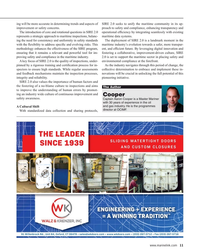 )
April 2024 - Maritime Reporter and Engineering News page: 11
)
April 2024 - Maritime Reporter and Engineering News page: 11ing will be more accurate in determining trends and aspects of SIRE 2.0 seeks to unify the maritime community in its ap- improvement or safety concerns. proach to safety and compliance, enhancing transparency and The introduction of core and rotational questions in SIRE 2.0 operational ef? ciency by
-
 )
April 2024 - Maritime Reporter and Engineering News page: 10
)
April 2024 - Maritime Reporter and Engineering News page: 10Maritime Safety © Roman/AdobeStock SIRE 2.0: Navigating the New Horizon of Maritime Safety By Captain Aaron Cooper, Programs Director, OCIMF he maritime industry is on the cusp of a signi? cant preparing vessel operators and vessel assurance teams for the transformation with the launch of the Ship
-
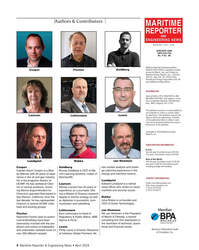 )
April 2024 - Maritime Reporter and Engineering News page: 4
)
April 2024 - Maritime Reporter and Engineering News page: 4Authors & Contributors MARITIME REPORTER AND ENGINEERING NEWS M A R I N E L I N K . C O M ISSN-0025-3448 USPS-016-750 No. 4 Vol. 86 Maritime Reporter/Engineering News (ISSN # 0025-3448) is published monthly Cooper Fischer Goldberg except for March, July, and October by Maritime Activity Reports, Inc.
-
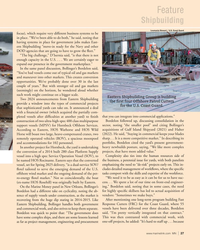 )
April 2024 - Marine News page: 27
)
April 2024 - Marine News page: 27Feature Shipbuilding Loumania Stewart / U.S. Coast Guard focus), which require very different business systems to be in place. “We’ve been able to do both,” he said, noting that having systems in place for government jobs makes East- ern Shipbuilding “move-in ready for the Navy and other DOD agencies
-
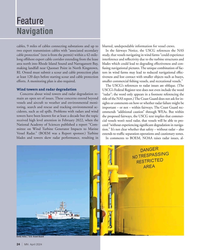 )
April 2024 - Marine News page: 24
)
April 2024 - Marine News page: 24Feature Navigation cables, 9 miles of cables connecting substations and up to blurred, undependable information for vessel crews. two export transmission cables with “associated secondary In the fairways Notice, the USCG references the NAS cable protection” (text is from the permit) within a 42-mile-
-
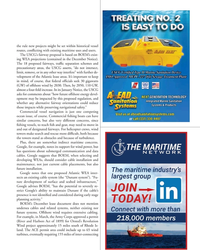 )
April 2024 - Marine News page: 23
)
April 2024 - Marine News page: 23ocean issue, of course. Commercial ? shing boats can have similar concerns, but also very different concerns, since ? shing vessels, to reach ? sh and gear, may need to move in and out of designated fairways. For helicopter crews, wind towers make search and rescue more dif? cult, both because the towers
